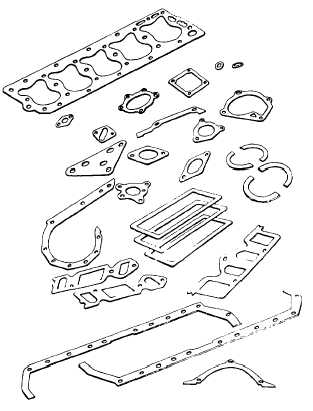are bolted to it so that they support the engine at three
or four points. These points of contact usually are
cushioned with rubber that insulates the frame and the
body of the vehicle from engine vibration and therefore
prevents damage to the engine supports and the
transmission.
Exhaust Manifold
The exhaust manifold is a tube that carries waste
products of combustion from the cylinders. On L-head
engines the exhaust manifold is bolted to the side of the
engine block on; overhead-valve engines it is bolted to
the side of the engine cylinder head. Exhaust manifolds
may be single iron castings or may be cast in sections.
They have a smooth interior surface with no abrupt
change in size (see fig. 12-1 1).
Intake Manifold
The intake manifold on a gasoline engine carries the
fuel-air mixture from the carburetor and distributes it as
evenly as possible to the cylinders. On a diesel engine,
the manifold carries only air to the cylinders. The intake
manifold is attached to the block on L-head engines and
to the side of the cylinder head on overhead-valve
engines. (See fig. 12-11.)
In gasoline engines, smooth and efficient engine
performance depends largely on whether the fuel-air
mixtures that enter each cylinder are uniform in
strength, quality, and degree of vaporization. The inside
walls of the manifold must be smooth to offer little
obstruction to the flow of the fuel-air mixture. The
manifold is designed to prevent the collecting of fuel at
the bends in the manifold.
The intake manifold should be as short and straight
as possible to reduce the chances of condensation
between the carburetor and cylinders. Some intake
manifolds are designed so that hot exhaust gases heat
their surfaces to help vaporize the fuel.
Gaskets
The principal stationary parts of an engine have just
been explained. The gaskets (fig. 12- 12) that serve as
seals between these parts require as much attention
during engine assembly as any other part. It is
impractical to machine all surfaces so that they fit
together to form a perfect seal. The gaskets make a joint
that is air, water, or oil tight. Therefore, when properly
Figure 12-12.-Engine overhaul gasket kit.
installed, they prevent loss of compression, coolant, or
lubricant.
MOVING PARTS OF AN ENGINE
The moving parts of an engine serve an important
function in turning heat energy into mechanical energy.
They further convert reciprocal motion into rotary
motion. The principal moving parts are the piston
assembly, connecting rods, crankshaft assembly
(includes flywheel and vibration dampener), camshaft,
valves, and gear train.
The burning of the fuel-air mixture within the
cylinder exerts a pressure on the piston, thus pushing it
down in the cylinder. The action of the connecting rod
and crankshaft converts this downward motion to a
rotary motion.
Piston Assembly
Engine pistons serve several purposes. They
transmit the force of combustion to the crankshaft
through the connecting rod. They act as a guide for the
upper end of the connecting rod. And they also serve as
12-13


